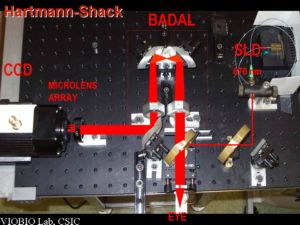
Hartmann-Shack wavefront sensor was built specifically to measure total aberrations in a chicken and mice model. The light source is a 680-nm Superluminiscent Diode.When the shutter is opened, the beam is directed into the eye. The light reflected from the retina exits the eye and is projected by a Focussing Block, a mirror and a microlens array, onto a high resolution CCD. The microlens array is placed on a pupil conjugate plane and the mirrors of the focussing block can moved to compensate for refractive errors. The pupil monitoring channel consists of an LED ring placed in front of the eye and a CMOS camera, allowing continuous viewing and pupil image recording. The system is very compact and with firewire and USB cameras can run from a portable computer and can be easily transported. The system allows fast measurements of aberrations, and therefore is ideal for awake animals.

Images captured by the CCD camera were processed using routines written by Matlab. We first detect automatically each retinal image and estimate the centroids by gaussian fitting. We used modal fitting to Zernike expansion of the sets of ray deviations to obtain wave aberration. A description of the implementation of this particular system can be found at Garcia de la Cera et al. 2006 and Elena Garcia de la Cera PhD thesis